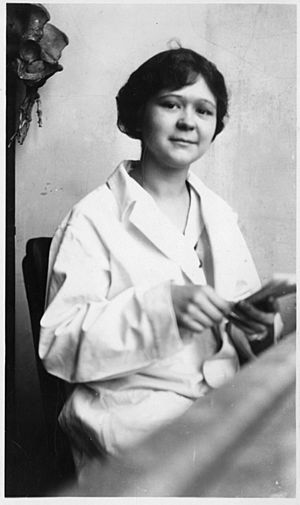Mildred Trotter facts for kids
Quick facts for kids
Mildred Trotter
|
|
|---|---|
 |
|
| Born | February 3, 1899 |
| Died | August 23, 1991 (aged 92) |
| Nationality | United States |
| Alma mater | Mount Holyoke College, Washington University in St. Louis, Oxford University |
| Scientific career | |
| Fields | Forensic history and anthropology |
| Institutions | Washington University School of Medicine |
Mildred Trotter (born February 3, 1899 – died August 23, 1991) was an American scientist. She was a pioneer in forensic anthropology, which is a special field where scientists study human bones to learn about people. This helps to identify people, especially in police investigations or after wars.
Contents
A Scientist's Journey
Mildred Trotter was born in Monaca, Pennsylvania. She loved learning and studied zoology and physiology (which is about animals and how bodies work) at Mount Holyoke College. She earned her first degree in 1920.
After college, she started working at Washington University in St. Louis. She was a researcher in the School of Medicine. Her hard work helped her earn two more degrees: a Master's in 1921 and a Ph.D. in anatomy in 1924. After that, she became a teacher of anatomy.
In 1925, Mildred Trotter received a special scholarship to study at Oxford University in England. While there, she wrote her first research paper about bones. It was called "The Moveable Segments of the Vertebral Column in Old Egyptians." This paper looked at the spines of ancient Egyptians.
Moving Up in Science
When she returned to Washington University School of Medicine, she quickly moved up in her career. She became an assistant professor and then an associate professor. In 1946, after much hard work, she became a full professor of Gross Anatomy. This was a very important step because she was the first woman to reach this high rank at Washington University.
Helping Identify Soldiers
In 1948, Dr. Trotter took a break from the university to help the U.S. Army. She worked in Hawaii at a special lab. Her job was to help identify the remains of American soldiers who had died. She was very good at her job, and her lab identified 94% of the remains they studied.
While working with the Army, she noticed that there wasn't enough information to guess a person's height or age from their bones. So, she started collecting her own measurements. This helped her create a large database of information about human bones.
Developing Important Formulas
In 1952, Dr. Trotter worked with another scientist, Goldine C. Gleser. Together, they created important math formulas. These formulas could figure out a person's height just by looking at their long bones (like leg or arm bones). They based these formulas on American soldiers who died in the Korean War. These formulas are still used widely today by forensic anthropologists.
Teaching and Retirement
Dr. Trotter continued to teach anatomy until 1967. She taught nearly 4,000 students during her career. Some of her students even became very famous scientists, like Nobel Prize winners Dr. Earl Wilbur Sutherland, Jr. and Dr. Daniel Nathans.
Even after she had to retire at age 68, she kept working. She continued her research, gave lectures, and wrote scientific papers until 1984. She was a founding member of the American Association of Physical Anthropologists. She was also the first woman to be their president from 1955 to 1957. She led other important scientific groups too.
Dr. Trotter passed away on August 23, 1991. She had wished for her body to be donated to the Washington University School of Medicine. This allowed students to continue learning from her, even after her death.
Awards and Honors
Dr. Trotter received many special awards and honors for her important work.
- She received several honorary degrees from different colleges. These included degrees from Western College for Women in 1956, Mount Holyoke College in 1960, and Washington University in 1980.
- In 1955, she was named a "Woman of Achievement in science" by a newspaper called the St. Louis Globe-Democrat.
- She was the first woman to receive the Viking Fund Medal in Physical Anthropology in 1956. This was a very important award from the Wenner Gren Foundation.
Today, there is a special award named after her called the Mildred Trotter Prize. It is given to students who do excellent work in the field of physical anthropology.

